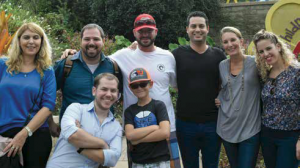Sherri Wisoff

Five Israeli delegates from Kiryat Yam, Tidewater’s Jewish community’s sister city in Israel, spent a whirlwind, and often rain-soaked week in Tidewater last month. During the week of September 18, these young adults visited most of Tidewater’s Jewish agencies, Jewish schools, synagogues and Jewish health care facilities. They networked, shared dinners and schmoozed with community leaders to gain an understanding of the richness and diversity of the Jewish community and to get a glimpse of what could be. They also toured some of Tidewater’s cultural and recreational resources—and had fun, too!
The group was comprised of two staff members and three volunteers of the Center for Young Adults in Kiryat Yam (a facility receiving financial aid from United Jewish Federation of Tidewater and local donors).
Sima Buhbut, Gal Yanoshevitz, Meital Solomon Raz, David Namer and Asher Itah visited Tidewater in a tour spearheaded by the Young Adult Division of the United Jewish Federation of Tidewater as part of a joint initiative with the American Jewish Joint Distribution Committee (JDC), World ORT and JAFI. The goal of the program is to establish deeper ties, partnerships and economic support for the struggling Jewish communities within Kiryat Yam. The current mission includes a two-part exchange—this trip by the Israelis, followed by a small group from Tidewater visiting Kiryat Yam in December.
Kiryat Yam
Surfers and sea gulls sweep along the quiet, underdeveloped beachfront of Kiryat Yam, a small town of 45,000, which is a short ride from Haifa in northern Israel.
In a presentation to UJFT’s Israel and Overseas committee and Kiryat Yam Young Adult committee, the five Israeli delegates shared some of the social and economic challenges they face in their city and their dream that one day, Kiryat Yam would have a thriving boardwalk beach community like Tidewater.
After listening to detailed plans for a future Kiryat Yam, David Brand, community member and part of the Israel & Overseas committee said, “You are right, it is all about the beach.”
But as the committee members asked more questions about the cities’ surrounding infrastructures, Bonnie Brand hit on the most revealing question of the evening, “What about restaurants, how many restaurants are in Kiryat Yam?” The answer was one. “One restaurant for 45,000 people—one restaurant and it’s kosher, so it’s closed on Shabbos? Well, that has to change!”
Kiryat Yam’s challenges
Founded in 1940 by 132 immigrants from displaced persons camps in Germany and Cyprus, Kiryat Yam, is a melting pot of diversity, due in part to its housing one of the country’s largest Absorption Centers.
The city has the largest concentration of Ethiopian Jews in Israel, with 35 percent of its residents and their descendants formerly from the Sub-Saharan country. Adding to this mix is a large number of Aliyot (immigrants to Israel) and their extended families, who settled in the area following the collapse of the Former Soviet Union.
Lacking major industries found in larger cities, Kiryat Yam is on the front line coping with the social challenge of integrating people with diverse cultural backgrounds and varying degrees of education and occupational training.
Few immigrants are initially prepared to step into the high-tech industries of modern Israel and have little hope of completing matriculation exams necessary for entry to college or university without outside support and guidance.
With its restless youth often seeking larger cities after their service in the Israeli Army, keeping talent within its own city is a constant challenge, say the visitors from Kiryat Yam. Today, 20 percent of the town is comprised of senior citizens, including 2,000 Holocaust survivors. Thirty percent require social service support, taxing a city budget squeezed by the need to supplement merger pensions.
American Jewish partnershipsSeeing obstacles as opportunities, World ORT, another UJFT overseas partner, and JDC identified Kiryat Yam as a city at risk. The organizations initiated ambitious plans for partnerships, actively working with the UJFT, government agencies, local officials and generous donors to bring resources, education and relief to the city.
In only a few short years, 2010 saw the opening of the Lipson Ethiopian Heritage Center, part of the Alex and Betty Schoenbaum Science, Educational, Cultural and Sports Campus, aimed at preserving and protecting the rich cultural heritage of the Ethiopian Jews. The larger Schoenbaum campus, also part of the ORT initiative in Kiryat Yam, boasts a science lab, a planetarium, an aquarium, library and an athletics stadium. Kiryat Yam’s Youth Orchestra adds yet another cultural dimension to the changing city landscape.
Kiryat Yam Center for Young Adults (CYA)
Young, passionate and dedicated people such as the five visitors from Kiryat Yam are impacting the mindset of hundreds of their peers and families through the many social services offered at the CYA. Skillful at adapting to the changing needs in Kiryat Yam, Meital Raz says, “Everything is built from the voice of our community.” David Namer adds, “If we see a problem, we just fix it.”
Their center has been completely renovated thanks to Tidewater donors and UJFT, which has also funded an Early Childhood Center addressing the needs of the younger children.
When asked about the most memorable part of his earlier visit to Kiryat Yam CYA, Eric Miller, a member of the Kiryat Yam Young Adult committee says, “ It’s the people, it is very cool to see how they (CYA) help the students with their resumes and help them find professions.”
Miller will be part of the YAD mission to Kiryat Yam in December to get insights on what else can be done to improve the well-being and prosperity of the residents there.
The missions to and from Kiryat Yam inspire dialogue, offer insights and new tools for its leadership, ensuring that the social and economic tides will soon be rising for Tidewater’s sister city in Israel.

